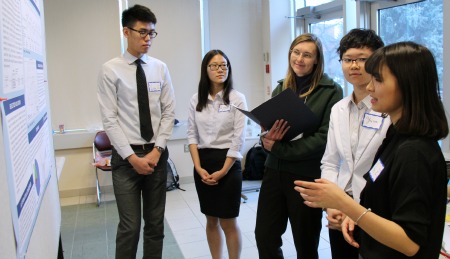
Chemical engineering professor Marnie Jamieson (centre, right) quizzes a team of students about their design project.
(Edmonton) There are as many different ways of testing knowledge as there are ways of gaining it. And students in a chemical engineering course recently spent a day explaining their design projects to a panel of judges from industry and academia as part of their final team project mark.
Students in chemical engineering professors John Shaw and Marnie Jamieson's Chemical Engineering 464 course were given a handful of design projects to choose from, exploring processes to treat CO2 so that it can be used in enhanced oil recovery operations, or to tap into the frigid waters of the North Saskatchewan River to help bolster the University of Alberta's cooling systems, or designing a permanent nitrogen vaporizer for the Suncor refinery were some of the choices.
At the end of the course, teams of students delivered their design solutions at a poster presentation. Judges made their rounds through the room, listening intently as students presented their plans. At the end of the presentations, judges and fellow students picked their top three teams based on student poster effectiveness and oral presentation of their design and evaluation based on sustainability criteria.
Interestingly, groups had to consider not only the technical challenges their project presented, but also the economics, safety, environmental metrics, regulations, risk management and net social benefit.
Teams designing a process to compress CO2 so it could be used in enhanced oil recovery projects were also looking at the tax implications: Alberta's new carbon tax encourages industry to reduce the amount of CO2 produced and this greenhouse gas can be injected into the round to force oil to the surface. The tax places value on CO2 so companies can now process and sell their waste to the oil industry.
"Engineering isn't always about finding the perfect solution, it's about finding the most feasible solution-you could come up with a perfect solution but if it doesn't make economic sense, no one is going to use it," explained Pradyumna Kedarisetti.
The group Kedarisetti worked with crunched numbers and found that on taxes alone-without counting revenue from selling CO2-their system would initially cost $62 million but after 13 years would save $4 million per year in taxes.
"The whole project put together everything we've learned this semester," added Lian Si, whose team also tackled the CO2 challenge.
Si's teammate, An Zhang, said the project was valuable because it meant putting theory into practice.
"Until you apply what you've learned, it's just theoretical knowledge," she said.
One industry judge, Jim Sorensen, brings a wealth of experience. He appreciated the fact that students were examining the costs of their projects.
"Not every project is going to be profitable," said Sorensen, who is an industry sponsor with the Chemical Engineering 465 (Design II) course. "That's one of the reasons we study something before we move forward."
Students in the 464 course will move into a more demanding and detailed design project in the upcoming semester, when they take on "capstone" projects in another course team, taught by Jamieson, Shaw, sessional instructors Len Church and Frank Vagi, and supported by about 25 industry clients sponsoring project concepts from local companies.
Sorensen is participating as an industry client. He has developed a plan he is entering into the $20-million X Prize CO2 competition. The worldwide contest offers $20 million to whoever comes up with breakthrough technology to cover CO2 into a product with the highest net value.
"I've got it all figured out," he said. "But I'm going to give it to a couple of teams of students to see if they can work it out too."
Team 18 and Team 3 won the students choice award Team 2 and Team 17 won the Judges Choice award.
Teams 18 and 2 were carbon dioxide compression teams. Team 18 was Lian Si, Aijing Wang, An Zhang, Yuan Zhang and Team 2 was Pradyumna Kedarisetti, Rishabh Sharma, Dhruv Vashisht, Pooja Wankhade.
Team 3, Manwei Huang, Jocelyn Ji, Yvonne Tian, Yingzhu Zhou worked on a nitrogen vaporization project.
Team 17 was Antonio Garcia Ponce, Daniel Kratochvil, Orysha McNeil, and Kristina Repchuk. Their project was compressed air energy storage.